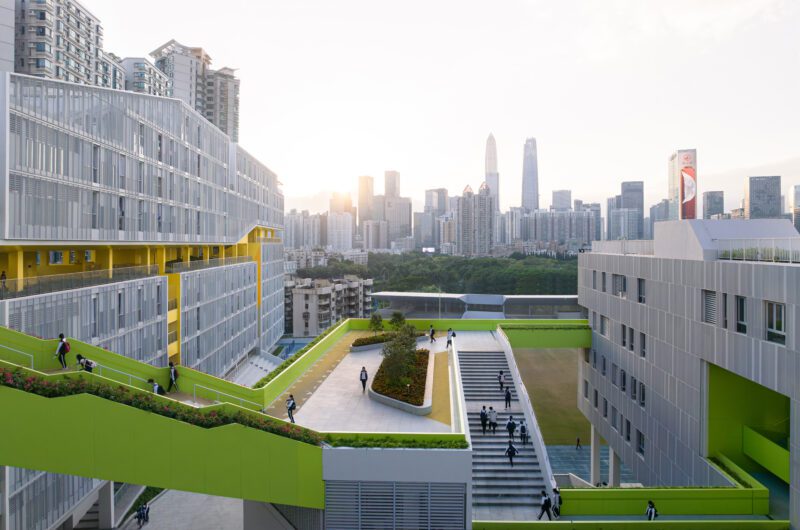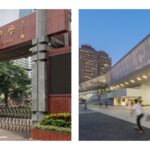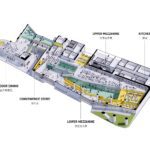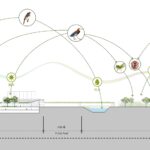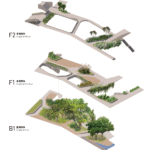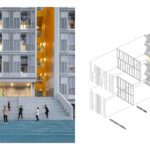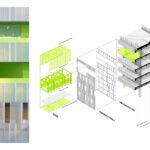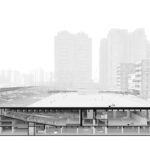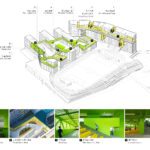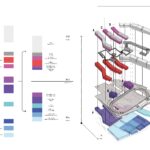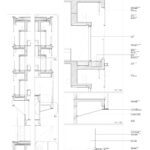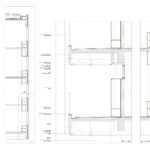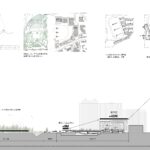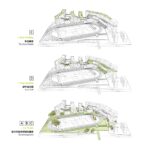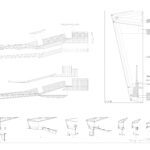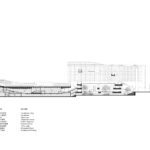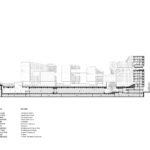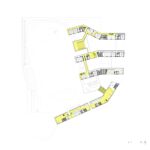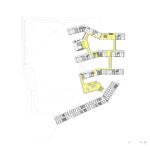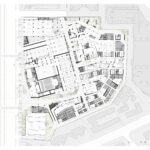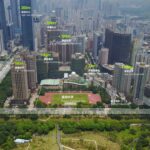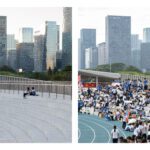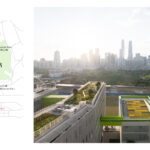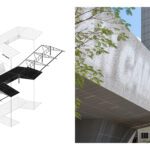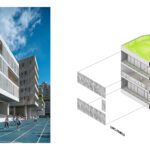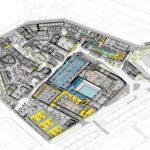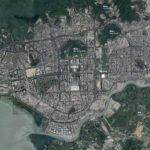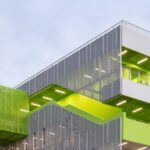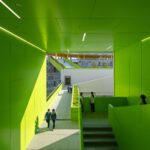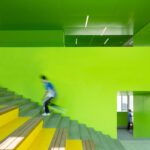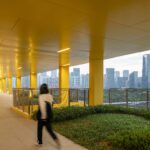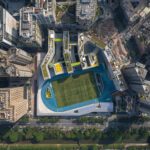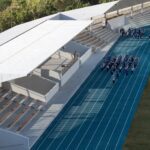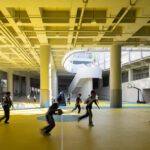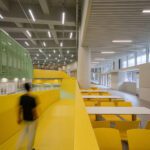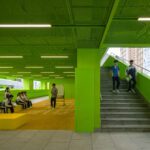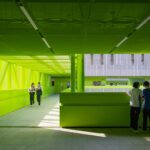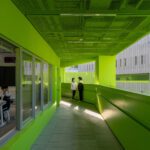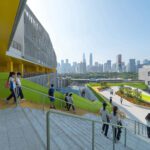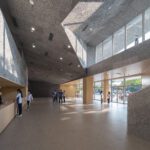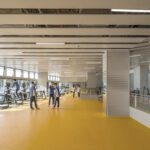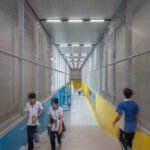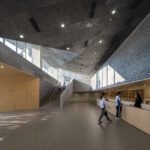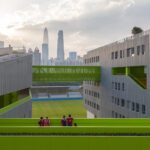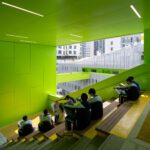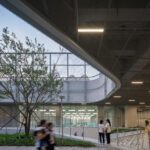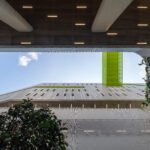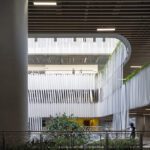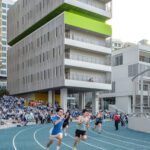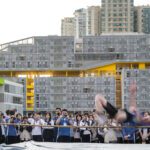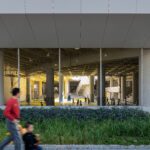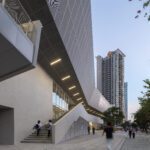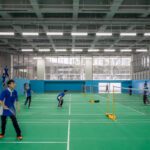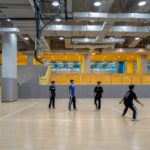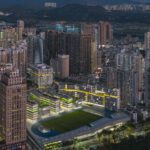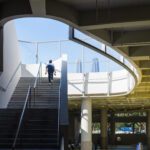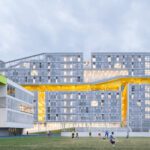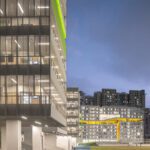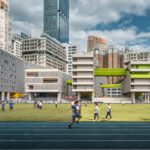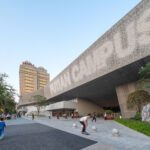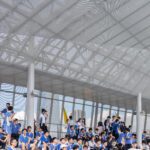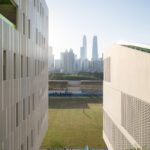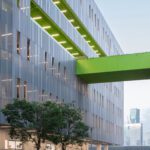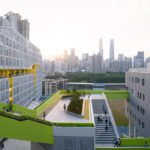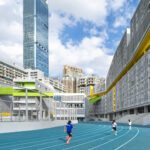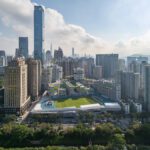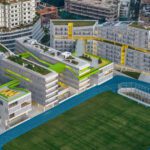Shared by the architects upon our invitation.
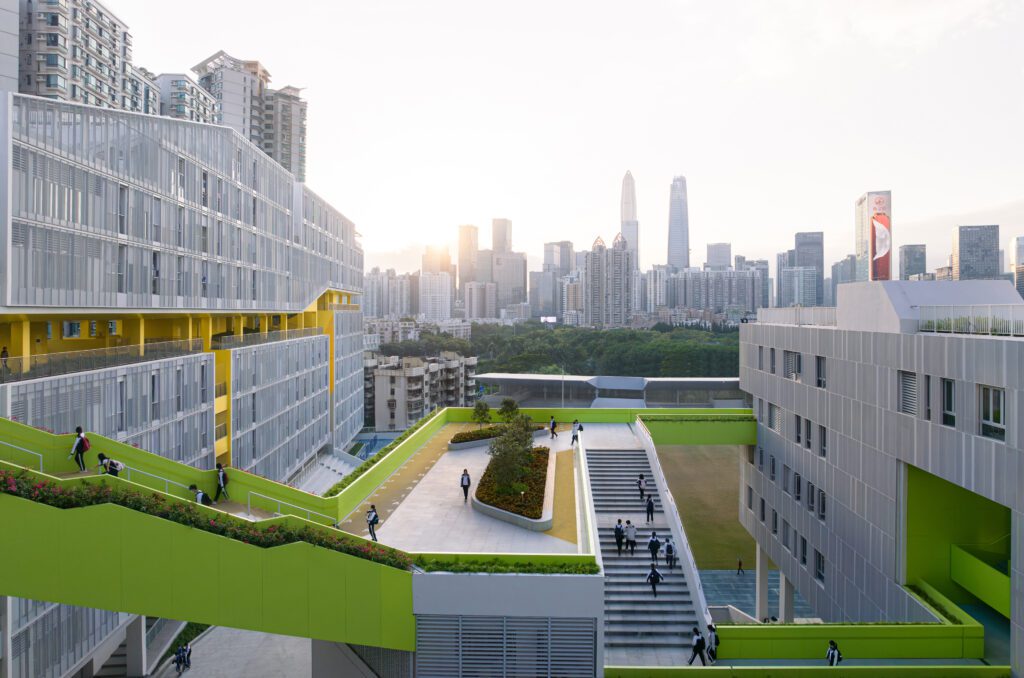
Futian Campus is a ground-breaking model of boarding school in the heart of Shenzhen, the most modern and dynamic Chinese metropolis. Its unicity comes from multiple factors: a context of extreme urban conditions, a very high density, a program layout that allows the school to have a transparent interface and most facilities to be shared with the neighbours, together make Futian Campus a prototype of “a new city within the city”.
The context
In 1980, when Shenzhen was given the status of “special economic zone”, the city was little more than a cluster of fishermen villages with a total population of 300,000 inhabitants in a strategic geographic position due to its extended coastline and its proximity to Hong Kong. Thanks to its special status the city has experienced the fastest process of urbanization in human history and nowadays it hosts almost 18 million inhabitants.
This unprecedented urban growth has had positive and negative effects: on the one hand it has spurred the city to become the engine of Chinese innovation (both in social and economic terms); on the other hand it has produced phenomena of hyper-densification due to scarcity of available soil – as a reference Shenzhen and Beijing have a similar population, but Shenzhen has only 1/8 of Beijing’s area – and lack of public facilities, particularly schools, which have not managed to keep up with the pace of growth of the rest of the city. To solve this deficit, in the last five years the local government has built more than 200 new schools.
Futian is located right at the centre of the new metropolis. Within a radius of a few kilometres from the school, one can observe the greatest variety of urban fabrics: Hong Kong green reserve land in the distance, Futian urban village (one of the few remains of the old town) in the immediate adjacency, already surrounded by new 100+ meters high residential towers, the new Central Park in front and on the other side of the park, the imposing skyscrapers of the CBD. In this context, the site of the school, locked by high-rise buildings on three sides, presented itself as one of the last plots of low density to be upgraded by the new development.
The city’s search for innovation resonated in the competition call for Futian High School, through a new urban manifesto called “8+1 – Futian New Campus Action Plan”. The competition brief asked architects to fundamentally rethink the idea of “campus” and explore new school typologies that had to address an unprecedented density and a changing educational system; in other words rethinking what a contemporary school campus should be and how it can operate locally, proposing new hybrid typologies that allow a stronger dialogue with its neighbouring community.
Urban strategy
The higher volumes of the teaching towers and the dorms are placed along the east and south boundaries of the site, creating a clear connection with the skyline of the adjacent buildings and a smooth degrading transition towards the urban void of the park. The imposing volume of the dorms (120m long and 50m high) is divided by a series of vertical and horizontal cuts that articulate the massing and bring down its scale to blend with the built fabric of the adjacent urban village.
Contrary to most Chinese schools that are arranged around a central focal point (usually the sports field), the buildings of Futian Campus are focusing outwards: through a series of visual corridors all the volumes open up to the mesmerizing views of Futian Central Park and the CBD. Thus students are not isolated from their neighbourhood anymore, but they are active spectators of the surrounding city.
A school without a fence: sharing facilities with the neighbours
Traditionally Chinese schools are urban islands with campus structures that isolate them from their neighbours and a lot of underused facilities that for security reasons are not accessible by external users. Futian Campus design challenges this configuration in favour of a much more flexible management scheme that partially opens the school to the local community.
In order to fulfil all the functional requirements of the brief in a relatively small site, one crucial design decision was to elevate the running track 7.4m above the road level, forming a thick podium that hosts all the larger pieces of the program, organized around a series of courtyards that create a porous mat structure. This configuration allowed to generate an unusual urban interface: rather than the standard blind fence, the school boundary along the main road is a transparent façade that gives direct access to a series of semi-public facilities. In the weekends or for special events, a group of indoor and semi-outdoor basketball, volleyball and badminton courts, a gym, a swimming pool, an exhibition space and a 1,000 seats auditorium (in total 13,600 m2 of public program) can all be opened to external users, thus transforming the school from a hermetic bubble into a civic centre.
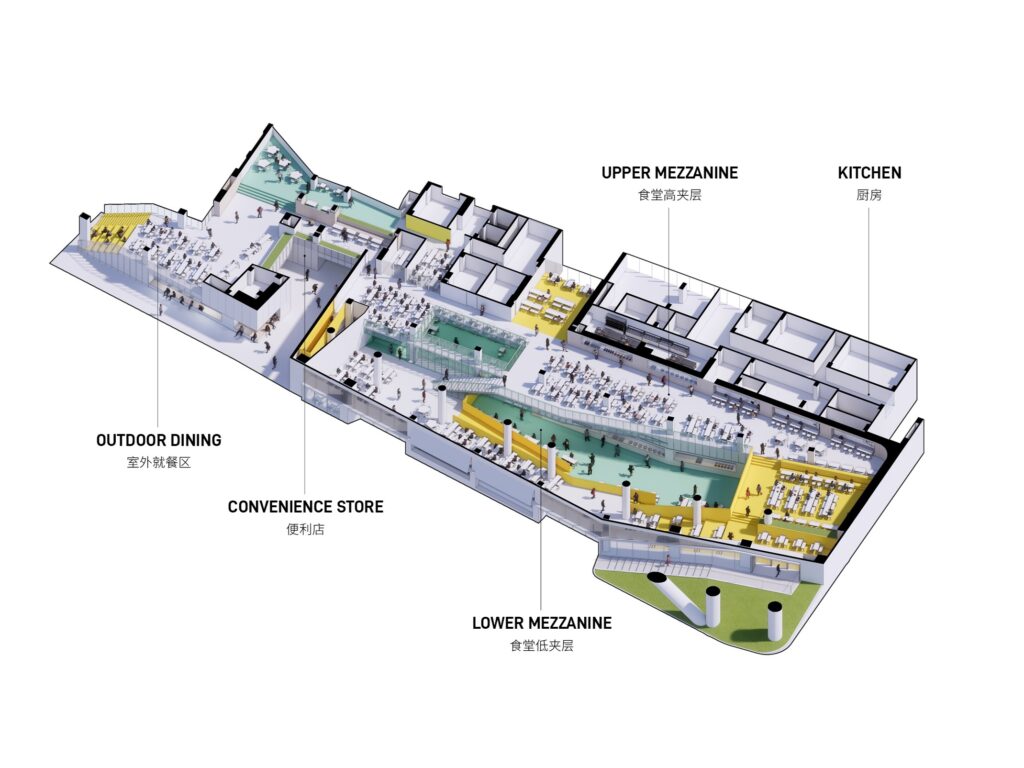
As a response to the irregular shape of the site, the running track on top of the podium is rotated 15 degrees anti-clockwise from the ideal north-south orientation to create a smoother connection with the buildings around it. As a result a triangular plaza is formed on the south-west corner of the plot, where the main gate is located. The entrance plaza is designed to give a generous space for the intense traffic of students and parents in school hours, but, especially in the evenings, it is also effectively a new active space open for public use.
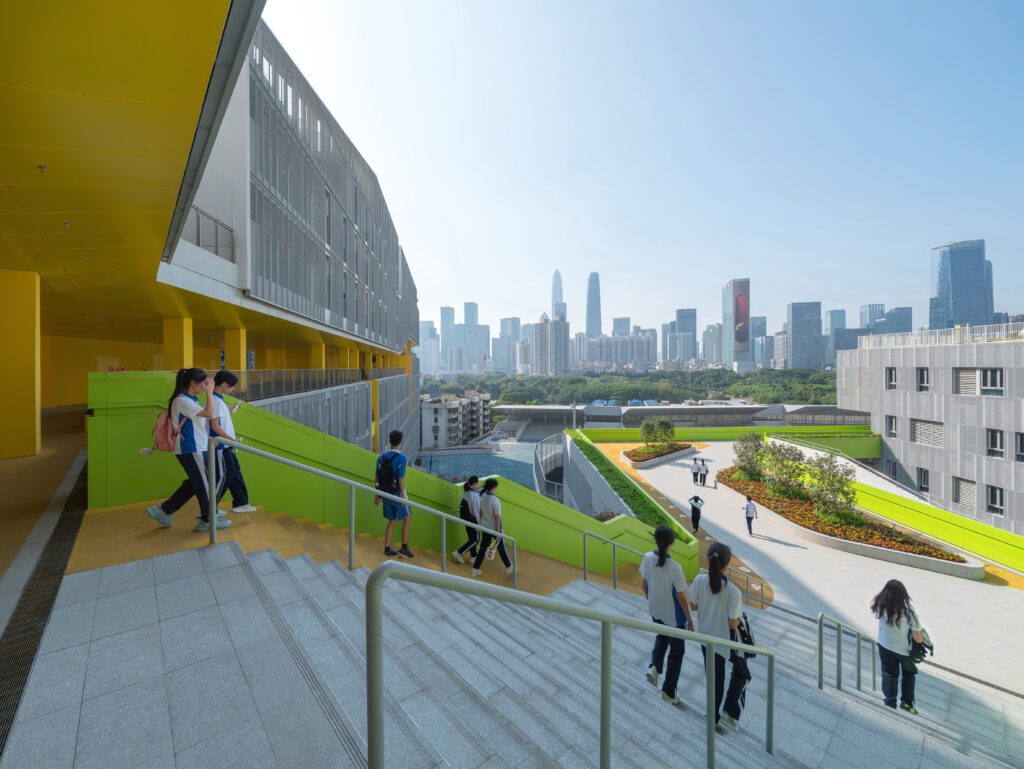
A large stair connects the street with the grades of the sports field, allowing the facility to operate as a proper professional district-level stadium with a covered seats capacity for more than 3,000 spectators. The design of the public circulation includes the plan for a future addition of a pedestrian bridge that would create a direct connection between the stadium and the park.
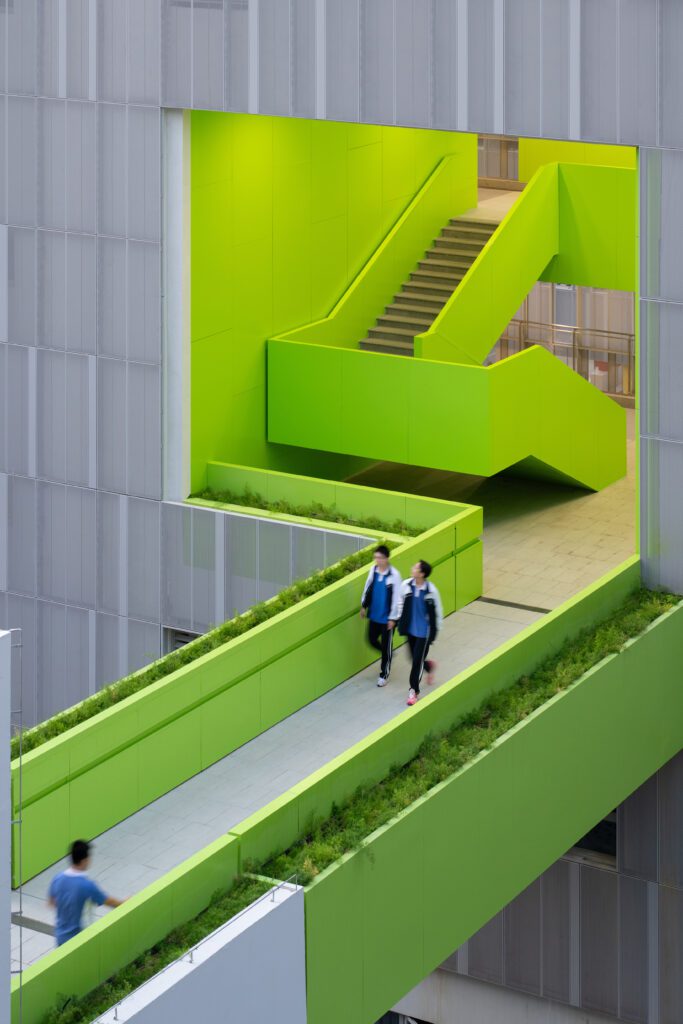
Mediating the extreme density
Futian Campus is a boarding school for a community of 3,000 students with a GFA of 120,000 m2 on a plot area of 41,000 m2. The project started as a renovation of an existing school, but the original floor area had to be quadrupled, making any preservation strategy impossible. With such numbers, the fulfilment of optimal solar conditions, proper natural ventilation, fire safety and other strict normative requirements was already a big achievement, but the most challenging design goal was to mitigate the sense of oppression that such high density could easily generate. For this scope, reMIX’s strategy focused on two main principles: maximizing porosity and “multiplying grounds”.
Achieving a high porosity, through the insertion of voids of different sizes both on the vertical axis (courtyards) and on the horizontal axis (covered terraces) is not only a valid design strategy to adapt to sub-tropical climatic conditions where natural ventilation is crucial, but it is also a way of creating new semi-outdoor spaces that operate at the human scale and help break down the imposing monumentality of the overall massing.

On a similar line, by “multiplying grounds” the massing process aims at creating as many active surfaces as possible, splitting the building volumes and displacing them on different interconnected levels. It is a spatial strategy that generates a distributed network of ever changing outdoor spaces and nodal filters through a large variety of connections and typologies of enclosure, smoothening up the transition between the landscape and the buildings.
The loop: much more than a circulation system The starting point in the design of the loop was a practical solution to a very challenging issue: 3,000 students live in a dorm building that reaches 13 floors of height and every morning they all need to move at once to reach their respective classrooms. How can one make such massive flow happen without heavily relying on elevators, not a feasible option for a school? The solution came from splitting up the volume of the dorms to create a public platform on the 9th floor that overviews the whole campus and connects to all the teaching towers on the 6th and 7th floor, through a system of bridges and stepped roofs. By splitting the high-rise buildings into two low-rise horizontal halves, this new elevated path cuts vertical movements by half, allowing students living or studying in the higher floors to move across the whole campus without the need of going up and down infinite flies of stairs.
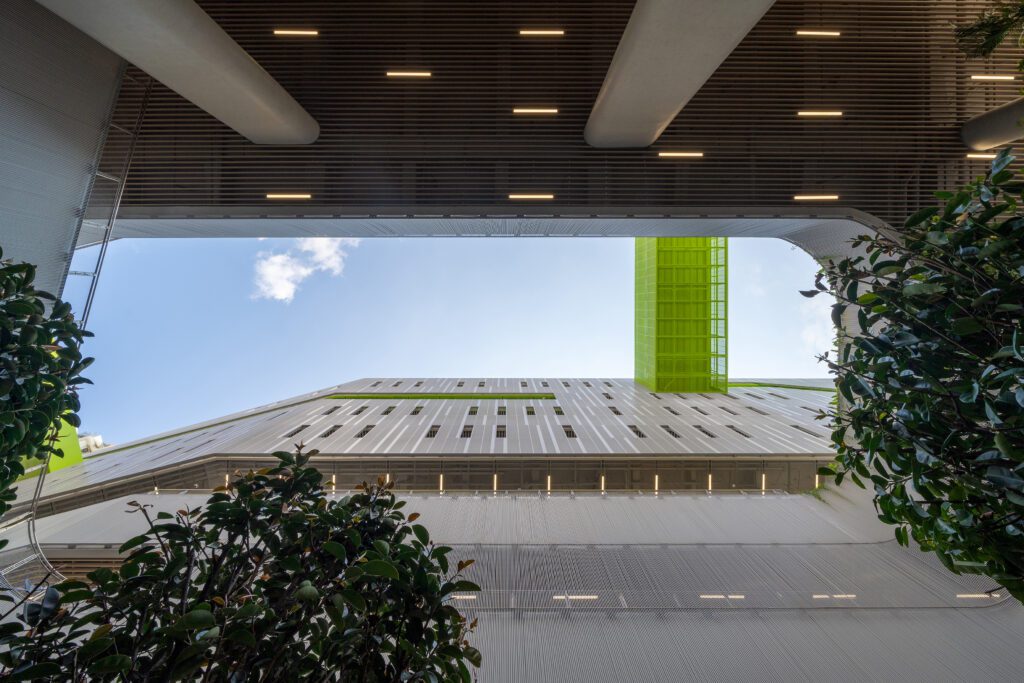
The loop, though, is not just a circulation system and it is certainly not driven only by efficiency, in fact none of the connections is straight nor follows shortest-walk principles. It is rather a three-dimensional combination of diverse social spaces (seating areas, open air classrooms, amphitheatres, roof gardens, etc.) that are designed to promote curiosity and inspire spontaneous activities and exchanges between students, recreating in a way all the interesting informal interactions that occur in the city. In other words, the loop is a meandering “social band” designed to organize the campus life, privileging diverse individual experiences in spite of social segregation.
An ecological campus
Futian campus is located along a very important corridor for migratory birds. In the old school, during the migration season, students could observe big flocks of birds resting on the grass of the sports field – one of the reason why the competition brief asked for a grass football pitch. The new massing of the campus degrading towards the park makes it a bird friendly eco-system.
A three-dimensional system of green spaces creates an interconnected ecological infrastructure. The design of the green system responds to multiple functional goals: while the green roofs are mainly designed to provide food for migratory birds, rain gardens and botanical exhibition areas in the lower floors provide environmental benefits (in terms of ecology and storm water management) as well as valuable educational material for the students.
Project Gallery:
Cite: “Futian High School Campus Shenzen, China / reMIX studio” 23 June 2025. GLSN. Accessed . https://theglsn.com/futian-high-school-campus-shenzen-china-remix-studio/

